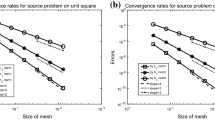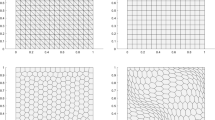Abstract
The classical weak formulation of the Helmholtz transmission eigenvalue problem can be linearized into an equivalent nonsymmetric eigenvalue problem. Based on this nonsymmetric eigenvalue problem, we first discuss the a posteriori error estimates and adaptive algorithm of conforming finite elements for the Helmholtz transmission eigenvalue problem. We give the a posteriori error indicators for primal eigenfunction, dual eigenfunction and eigenvalue. Theoretical analysis shows that the indicators for both primal eigenfunction and dual eigenfunction are reliable and efficient and that the indicator for eigenvalue is reliable. Numerical experiments confirm our theoretical analysis.






Similar content being viewed by others
References
Cakoni, F., Gintides, D., Haddar, H.: The existence of an infinite discrete set of transmission eigenvalues. SIAM J. Math. Anal. 42, 237–255 (2010)
Colton, D., Kress, R.: Inverse acoustic and electromagnetic scattering theory. In: Applied Mathematical Sciences, 3rd edn., vol. 93, Springer, New York (2013)
Colton, D., Monk, P., Sun, J.: Analytical and computational methods for transmission eigenvalues. Inverse Probl. 26, 045011 (2010)
Sun, J.: Iterative methods for transmission eigenvalues. SIAM J. Numer. Anal. 49, 1860–1874 (2011)
Ji, X., Sun, J., Turner, T.: Algorithm 922: a mixed finite element method for helmholtz trans-mission eigenvalues. ACM Trans. Math. Softw. 38, 29 (2012)
An, J., Shen, J.: A spectral-element method for transmission eigenvalue problems. J. Sci. Comput. 57, 670–688 (2013)
Ji, X., Sun, J., Xie, H.: A multigrid method for Helmholtz transmission eigenvalue problems. J. Sci. Comput. 60, 276–294 (2014)
Cakoni, F., Monk, P., Sun, J.: Error analysis for the finite element approximation of transmission eigenvalues. Comput. Methods Appl. Math. 14, 419–427 (2014)
Li, T., Huang, W., Lin, W., Liu, J.: On spectral analysis and a novel algorithm for transmission eigenvalue problems. J. Sci. Comput. 64, 83–108 (2015)
Yang, Y., Han, J., Bi, H.: Error estimates and a two grid scheme for approximating transmission eigenvalues. arXiv:1506.06486v2 [math. NA] 2 Mar (2016)
Babuska, I., Rheinboldt, W.: Error estimates for adaptive finite element computations. SIAM J. Numer. Anal. 15, 736–754 (1978)
Verfurth, R.: A posteriori error estimators for the Stokes equations. Numer. Math. 55, 309–325 (1989)
Ainsworth, M., Oden, J.T.: A unified approach to a posteriori error estimation using element residual methods. Numer. Math. 65, 23–50 (1993)
Chen, Z., Nochetto, R.: Residual type a posteriori error estimates for elliptic obstacle problems. Numer. Math. 84, 527–548 (2000)
Du, S., Zhang, Z.: A robust residual-type a posteriori error estimator for convection–diffusion equations. J. Sci. Comput. 65, 138–170 (2015)
Zienkiewicz, O., Zhu, J.: The superconvergent patch recovery and a posteriori error estimates. Part 1: the recovery technique. Int. J. Numer. Methods Eng. 33, 1331–1364 (1992)
Xu, J., Zhang, Z.: Analysis of recovery type a posteriori error estimators for mildly structured grids. Math. Comput. 73, 1139–1152 (2004)
Ainsworth, M., Oden, J.: A Posterior Error Estimation in Finite Element Analysis. Wiley-Interscience, New York (2011)
Verfurth, R.: A posteriori Error Estimation Techniques. Oxford University Press, New York (2013)
Shi, Z., Wang, M.: Finite Element Methods. Science Press, Beijing (2013)
Heuveline, V., Rannacher, R.: A posteriori error control for finite approximations of elliptic eigenvalue problems. Adv. Comput. Math. 15, 1–4 (2001)
Heuveline, V., Rannacher, R.: Adaptive FE eigenvalue approximation with application to hydrodynamic stability analysis. In: Fitzgibbon, W., et al. (eds.) Proceedings of the International Conference on Advances in Numerical Mathematics, Moscow, Sept 16–17, vol. 2005, pp. 109–140. Institute of Numerical Mathematics RAS, Moscow (2006)
Carstensen, C., Gedicke, J.: An oscillation-free adaptive FEM for symmetric eigenvalue problems. Numer. Math. 14, 401–411 (2011)
Carstensen, C., Gedicke, J., Mehrmann, V., Miedlar, A.: An adaptive homotopy approach for non-selfadjoint eigenvalue problems. Numer. Math. 119, 557–583 (2011)
Gedicke, J., Carstensen, C.: A posteriori error estimators for convection–diffusion eigenvalue problems. Comput. Methods Appl. Mech. Eng. 268, 160–177 (2014)
Giani, S., Graham, I.: A convergent adaptive method for elliptic eigenvalue problems. SIAM J. Numer. Anal. 47, 1067–1091 (2009)
Rynne, B., Sleeman, B.: The interior transmission problem and inverse scattering from inhomogeneous media. SIAM J. Math. Anal. 22, 1755–1762 (1991)
Blum, H., Rannacher, R.: On the boundary value problem of the biharmonic operator on domains with angular corners. Math. Method Appl. Sci. 2, 556–581 (1980)
Babuska, I., Osborn, J.: Eigenvalue problems. In: Ciarlet, P.G., Lions, J.L. (eds.) Finite Element Methods (Part 1), Handbook of Numerical Analysis, vol. 2, pp. 640–787. Elsevier Science Publishers, North-Holand (1991)
Chatelin, F.: Spectral Approximations of Linear Operators. Academic Press, New York (1983)
Yang, Y., Sun, L., Bi, H., Li, H.: A note on the residual type a posteriori error estimates for finite element eigenpairs of nonsymmetric elliptic eigenvalue problems. Appl. Numer. Math. 82, 51–67 (2014)
Dai, X., Xu, J., Zhou, A.: Convergence and optimal complexity of adaptive finite element eigenvalue computations. Numer. Math. 110, 313–355 (2008)
Chen, L.: An integrated finite element method package in MATLAB, Technical Report, University of California at Irvine (2009)
Acknowledgments
We cordially thank the referees and the editor for their valuable comments that led to the large improvement of this paper.
Author information
Authors and Affiliations
Corresponding author
Additional information
Project supported by the National Natural Science Foundation of China (Grant No. 11561014).
Rights and permissions
About this article
Cite this article
Han, J., Yang, Y. An Adaptive Finite Element Method for the Transmission Eigenvalue Problem. J Sci Comput 69, 1279–1300 (2016). https://doi.org/10.1007/s10915-016-0234-5
Received:
Revised:
Accepted:
Published:
Issue Date:
DOI: https://doi.org/10.1007/s10915-016-0234-5




